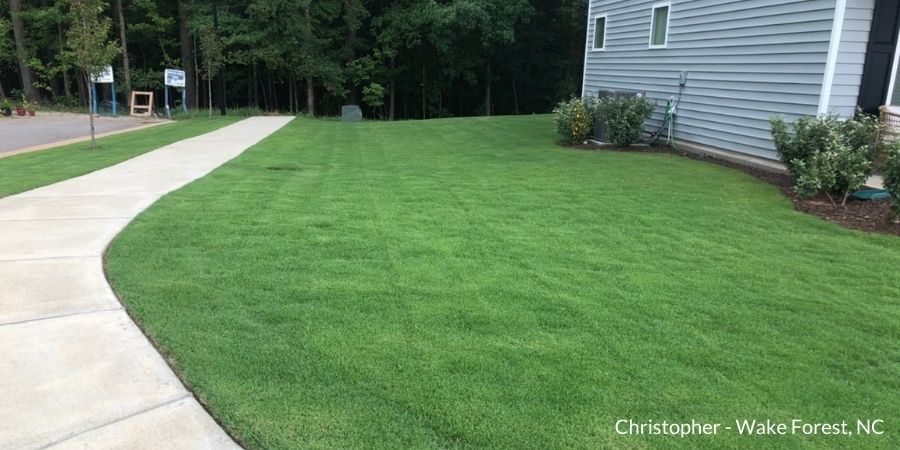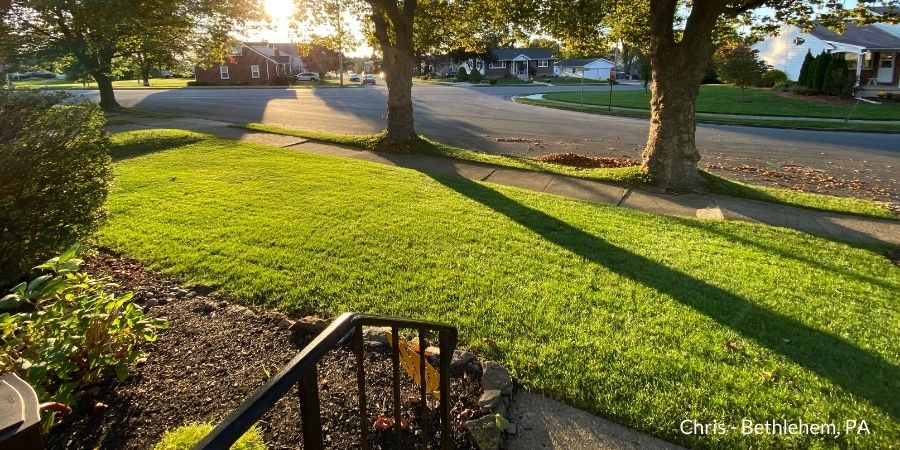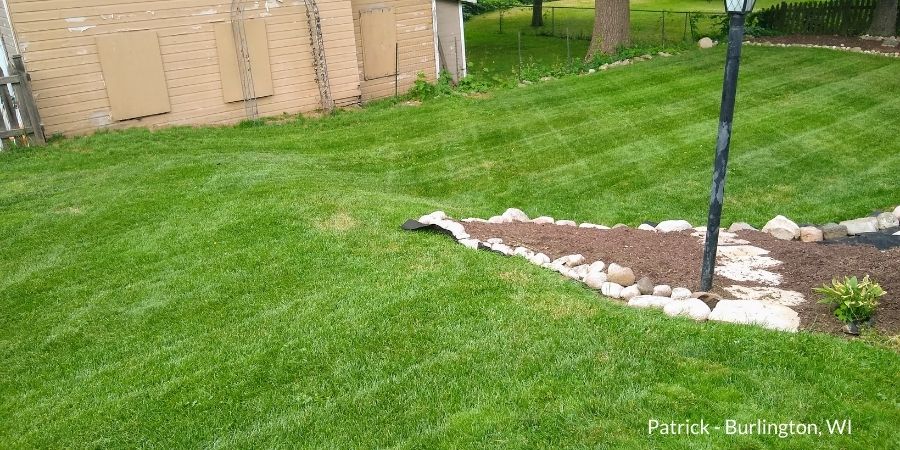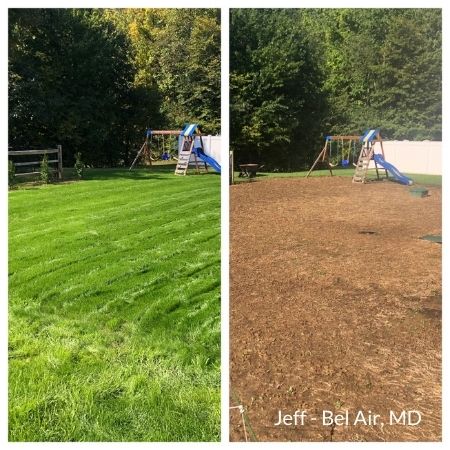Fall Lawn Care for Beginners
- Milorganite AgronomistSeptember 11, 2021
Fall is the most important time of year for lawn care. Learning what to do, when to do it and how will help you maintain the health and quality of your lawn for years to come. Here are the most important fall lawn care tips for beginners.
Fall Lawn Care Resources to Determine Soil Temperature, Average Date of First Frost
Fall lawn care is based on weather, soil temperature, dormancy, and the average date of the first frost. Since these aren’t dates written in stone—or ice, as the case may be—here are two handy resources that will make fall lawn care easier to schedule and increase your chance of success. The first provides soil temperatures based on your zip code. The Old Farmer’s Almanac is the other resource, which provides the average dates for the first frost, also by zip code. You’ll need these later on.

Mow High Now. Mow Low Later.
You’ll change the mowing height a couple of times in the fall.
Turfgrass will continue to grow until the weather turns cold enough that it goes dormant. While it’s actively growing, continue to mow at the height suggested for your turfgrass variety. Cut off no more than 1/3 of the grass blade at a time.
When the weather starts to cool down, start mowing your lawn at the highest possible setting. Longer grass produces a deeper root system. The increased mowing height provides more surface area for turfgrass to produce chlorophyll and nourish roots as it prepares for winter dormancy.
Grass length is an indicator of root depth. In general, turfgrass roots grow as deep as the grass is long. Longer turfgrass shades more of the soil and helps prevent weed seeds from germinating.
After the turfgrass has gone dormant, it’s time to mow low. Since turfgrass is no longer producing chlorophyll, you can drop the mowing height to 2” for cool-season grasses and 1” for warm-season grasses for the last cut of the season.
You can save time this fall by using your mulching mower to chop up fallen leaves to about the size of a quarter and leave it in place to decompose. (As long as you see grass, the leaves are mulched small enough.) It adds organic matter to the lawn and the nitrogen it adds is equivalent to one seasonal application. It may take a couple of passes to get the pieces small enough, but it’s still easier than raking.
Now is the time to get ready for spring and have your mower maintained and blade sharpened before you store it for the winter. Dull blades tear and damage blades of grass making them more prone to disease and drying out. In an ideal world, the blade should be sharpened 2–3 times a year.
Fall Is the Best Time to Fertilize Your Lawn
If you only have time to apply fertilizer once a year, do it in the fall. Growing conditions are good for turfgrass and a boost of nutrients makes it better able to withstand winter.
There are two fall applications of Milorganite: early fall feeding and dormant feeding. Milorganite is applied around Labor Day for the fall feeding for both cool-season and warm-season grasses for the early fall feeding. This feeding provides nutrients your turf can use immediately, while it’s actively growing, and recovering from the stress of summer.
What is a dormant feeding? Think of the dormant feeding as a really early spring feeding. Milorganite will begin releasing its nutrients when the weather and soil conditions are right in spring and grass begins to come out of dormancy. You’re getting a jump start on next season’s lush, green lawn.
The dormant feeding of cool-season grasses is applied after the first frost, but before the first deep freeze or snowfall, likely between Halloween and Thanksgiving depending on where you live. This ensures the dormant feeding is applied after the grass is dormant.

Use a low-nitrogen, slow-release fertilizer like Milorganite for the dormant lawn feeding. If a quick-release fertilizer is used, the nutrients are immediately released and may encourage growth, which is exactly what you don’t want to happen in late fall. It can also lead to nutrient runoff into your local waterways.
Avoid fertilizing warm-season grasses too late in fall. The nutrients will encourage growth while the turfgrass is trying to go dormant. The dormant feeding of warm-season grasses is generally applied around early October. There are exceptions to this. Centipedegrass and Bahiagrass do better when fertilized in spring and summer, and to help prevent winterkill, avoid fertilizing these varieties in the fall.
If you overseeded your warm-season lawn for winter color, you can apply Milorganite at the same time. The second fall feeding for warm-season grasses is one month before dormancy, often around early-October, or one month before the first killing frost.
Avoid fertilizing within 10 feet of any body of water. This buffer helps to prevent nutrient runoff that pollutes our water.
Sweep fertilizer off walks and drives to avoid nutrient runoff into area waterways and drinking water. Always follow local ordinances and blackout dates for applying fertilizers and herbicides.
Spot Treat for Weeds
If your lawn has only a handful of weeds, consider removing them by hand using a weed digger to first loosen them. Some weed removal tools are handheld, others are stand-up models. Choose a weeding tool that you’ll be comfortable using. It’s worth the investment to purchase a durable model. It will last you countless seasons.
It’s nearly impossible to pull a weed from rock-hard soil. Pulling weeds by hand is easier after rain when the soil is moist. If there’s no rain in the forecast, water the lawn the day before you plan on attacking the weeds.
Identify the weeds in your lawn. By doing a little research, you’ll learn what types of root systems they have, which is helpful to know when you’re trying to pull them out. Dandelions, for example, have a tap root. It’s a single root that can be several feet deep. To effectively remove dandelions, the entire taproot must be removed. If just the leaves are removed, it’s going to grow back.
If there are more weeds than you can comfortably remove by hand, it’s time to spot-treat weeds using a broadleaf herbicide. Some herbicides are weed-specific, which is another reason to first identify the weeds.
Spot treating weeds with an herbicide is particularly effective in the fall. Like grass, weeds are storing nutrients for the winter ahead. It’s actively taking up nutrients, which means the herbicide will be more readily taken up as well.
Use a broad-leaf herbicide and ensure it’s compatible with the turfgrass varieties in your lawn. Some broad-leaf herbicides kill some grass varieties. Don’t use a non-selective herbicide! It kills everything. Everything!
When using any lawn care chemicals, follow all label instructions carefully.
Fall is the Best Time to Repair Bare Spots in the North
Your lawn may show signs of wear-and-tear by the end of summer, whether it’s from drought, heavily used play areas, or natural paths. Bare patches in your lawn are inevitable. Understanding how to repair them is an important addition to your shed of lawncare skills.
Bare spots can also be caused by turfgrass diseases or pests. If this is the case, first identify and treat the problem. If you don’t address it now, before repairing the area, you may be dealing with the same problem next season and repairing the same area again.
If you have cool-season grass varieties, fall is the best time of year to repair bare patches. The conditions are ideal for grass to grow—warm days and cool nights. Timing lawn repairs makes a difference. When it’s done in early fall, the new grass will have time to mature before winter hits.

Repairs to warm-season grasses are best done in late spring, but how bare patches are repaired remains the same.
I covered the steps of how to repair bare patches in your lawn in a recent post, Drought, Dormancy, and Damage: Repairing Drought-Damaged Lawns by Overseeding, Patching, or Re-seeding. Here are some additional tips:
How to Repair Bare Patches in Your Lawn: Tips for Beginners
Eliminate competition by removing weeds and any remaining grass. Pull up what you can, making sure to remove the roots. If it’s a large area, use a natural method to kill off any unwanted vegetation, such as solarization. Cover the area with 1–2 layers of 2–3 mil transparent-plastic tarp, which is more effective than black or opaque plastic, and let the sun “cook” the area. If there are problematic weeds, spot treat with a non-select herbicide.
If the soil is particularly compacted, loosen the top few inches of soil using a metal rake. You can amend the soil by working in about a ¼” of compost, which helps loosen soil and adds nutrients. Add topsoil to level out the area and tamp down the area using a rake. The level, relatively smooth soil will help to ensure good seed-to-soil contact. If you’re not using a patch mix, you can lightly cover the seed with ¼” compost or topsoil. Tamp it down again for good seed-to-soil contact.
Your goal is to broadcast about 10–15 grass seeds per square inch. It’s possible to broadcast too much seed, which can cause competition among seedlings and mature grass.
Mulch the area using hay, peat, or some other mulch material. Don’t use a material that has seeds, such as straw.
Water the patch lightly to keep it moist while the seeds germinate. This may require that you water lightly multiple times a day depending on the weather.
Be aware of the days to germination for the turfgrass planted, some of which can take a few weeks. Check the seed package label for the number of days to germination.
Use Milorganite when patching bare spots. It doesn’t contain salts, which can burn grass, especially tender shoots. It’s low nitrogen and releases nutrients slowly, at a rate the young grass can use.
Make your own DIY lawn repair mix. It’s easy and inexpensive, and you have control over the turfgrass variety you use.
Make your own lawn repair kit by mixing together one-part grass seed with three-parts soil or compost. You can also save a step by fertilizing at the same time by mixing in Milorganite.
Here’s the recipe as ratios so you can make any amount of mix you’d like.
- 1:3 of turfgrass seed to soil or compost by volume.
- 1:4 of turfgrass seed to Milorganite by weight.
Here’s an example:
- Turfgrass seed: 1 cup (You’ll also need the weight of one cup of grass seed.)
- Soil or compost: 3 cups
- Milorganite: 4 times the weight of the seed
How to Overseed a Thin, Sparse Lawn
If your lawn is looking a bit tired and thin, but not overrun by weeds, it may benefit from overseeding. It helps thicken sparse lawns and is an opportunity to introduce newer varieties of turfgrass that are more disease and drought-resistant. A dense lawn is also your best defense against weeds.
The warm soil and cool air are the conditions sprouting turfgrass needs, which is why fall is the best time to overseed cool-season lawns. Warm-season grasses are overseeded at different times of the year, depending on why you’re overseeding, which I’ll cover shortly.
Like cool-season grasses, warm-season grass varieties are used to overseed to improve a sickly lawn.
The most recent post on Drought, Dormancy, Damage, and Repair provides step-by-step instructions for overseeding your lawn. Here are some additional tips to help ensure your success as a beginner.
Overseeding isn’t a shortcut for re-seeding your lawn. They’re not interchangeable. If your lawn is more than 50% weeds, you’ll have to re-seed which is starting over with a blank slate.

Seed and fertilize at the same time to reduce your workload. Mix 1-part grass seed to 4-parts Milorganite by weight. Milorganite is low-nitrogen and non-burning.
Warm-season grasses are overseeded with cool-season grasses for winter color. Overseed in late-summer or early-fall, when summer’s warm-season grasses are going dormant. Cool-season turfgrass will die when the heat returns.
Turfgrass seed labels have a lot of information, which is required by law. Knowing how to interpret the label will help you choose turfgrass varieties that will thrive in your yard. It provides information such as days to germination and quantity of weed seeds mixed in with the turfgrass seed.

